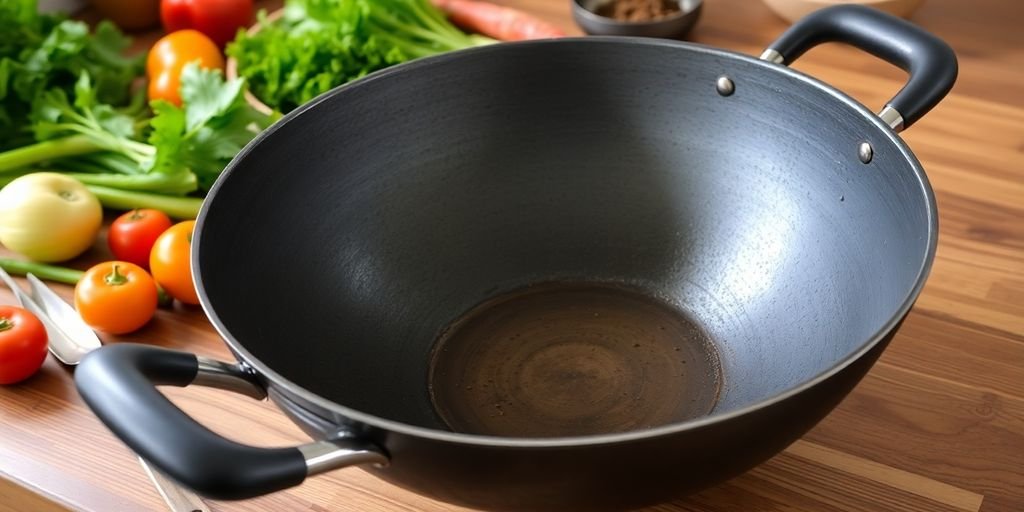
Caring for your carbon steel wok is essential for keeping it in great shape and enhancing your cooking experience. This guide will provide you with simple yet effective tips and tricks to master the art of wok care. Whether you’re a beginner or have some experience, these key takeaways will help you maintain your wok and enjoy delicious meals for years to come.
Key Takeaways
- Clean your wok with hot water and a soft sponge after each use.
- Always dry your wok completely to prevent rust.
- Re-season your wok regularly to keep its non-stick surface.
- Handle your wok with care to enjoy it for a long time.
- If rust appears, clean it off and re-season to restore its quality.
Understanding Carbon Steel Wok Care
Why Carbon Steel is Ideal for Woks
Carbon steel is a fantastic choice for woks because it heats up quickly and retains heat well. This makes it perfect for stir-frying, where high heat is essential. A well-seasoned carbon steel wok can enhance the flavors of your dishes.
The Science Behind Seasoning
Seasoning your wok involves creating a natural, non-stick layer on its surface. This process not only protects the metal but also improves with each use. The seasoning forms a patina that makes cooking easier and more enjoyable.
Common Misconceptions About Carbon Steel Woks
Many people think carbon steel woks are hard to maintain, but that’s not true! Here are some common myths:
- Myth 1: Carbon steel woks rust easily.
- Myth 2: They require special cleaning products.
- Myth 3: You can’t use soap on them.
Remember, with proper care, your carbon steel wok can last for years and become a beloved kitchen tool!
Initial Steps for Preparing Your Wok
Removing the Protective Coating
Before you start seasoning your wok, it’s important to remove any protective coating that may be on it. This coating is usually a type of oil that prevents rust during shipping. To do this:
- Wash the wok with hot, soapy water using a soft sponge.
- Rinse thoroughly to ensure all soap is gone.
- Dry the wok completely with a clean cloth or paper towels.

Essential Tools and Materials
Gather the following tools and materials to prepare your wok:
- Soft sponge
- Mild dish soap
- Paper towels or a clean cloth
- High heat source (like a stovetop or outdoor burner)
Safety Precautions During Preparation
When preparing your wok, safety is key. Here are some tips to keep in mind:
- Always handle the wok with care, especially when it’s hot.
- Ensure your workspace is well-ventilated to avoid smoke buildup.
- Avoid direct contact with the heated wok to prevent burns.
Remember, taking these initial steps is crucial for a successful seasoning process. A well-prepared wok will enhance your cooking experience!
The Seasoning Process Explained
Step-by-Step Guide to Seasoning
To season your carbon steel wok, follow these simple steps:
- Heat the wok: Start by heating your wok on medium-high heat to open its pores.
- Apply oil: Use a paper towel to wipe a thin layer of vegetable oil over the interior. This is crucial for creating a non-stick surface.
- Smoke it out: Heat the wok again until the oil starts to smoke. This is where the magic happens! Repeat this process a few times to build a good layer of seasoning.
Best Oils for Seasoning
Choosing the right oil is important. Here are some oils that work well:
- Canola oil
- Grapeseed oil
- Peanut oil
These oils have a high smoke point, making them ideal for seasoning your wok.
Common Seasoning Mistakes to Avoid
When seasoning your wok, keep these tips in mind:
- Don’t use too much oil; it can create a sticky surface.
- Avoid overheating the wok, as this can damage the seasoning.
- Always clean the wok before starting the seasoning process.
Remember, patience is key! Good seasoning takes time and care to achieve the best results.
Maintaining Your Seasoned Wok
After successfully seasoning your wok, it’s essential to keep it in great condition. Here are some key tips to help you maintain your wok:
Daily Cleaning Routine
- Wash your wok with warm water and a soft sponge after each use. Avoid using harsh soaps or scrubbers, as they can strip the seasoning right off your wok.
- Make sure to dry it thoroughly to prevent rust. Leaving water on the surface can lead to rusting.
- If food sticks, use a gentle scrubber, but be careful not to damage the seasoning.
Proper Storage Techniques
- Store your wok in a dry, cool place. This helps maintain the seasoning and prevents rust.
- If you live in a humid area, consider placing a thin layer of oil on the surface before storing it to protect against moisture.
- Avoid stacking other cookware inside your wok, as this can scratch the surface.
Refreshing the Seasoning
- Periodically, you may need to refresh the seasoning. To do this, apply a thin layer of oil and heat the wok until it smokes. Let it cool, then wipe away any excess oil.
- This process helps maintain the non-stick properties of your wok and keeps it looking great.
Remember, caring for your wok is an ongoing process. Treat it with respect, and it will reward you with delicious meals for years to come!
Advanced Tips for Wok Care
Dealing with Rust
Rust can be a common issue for carbon steel woks, but it’s manageable. Here are some steps to help you:
- Scrub the Rust: Use steel wool or a scrubber to remove rust spots.
- Wash and Dry: Rinse the wok thoroughly and dry it completely to prevent further rusting.
- Re-season: Apply a thin layer of oil and heat the wok until it smokes to restore its protective coating.
Achieving a Perfect Non-Stick Surface
To ensure your wok remains non-stick, follow these tips:
- Use the Right Oil: Choose oils with high smoke points, like canola or grapeseed oil.
- Layering Technique: Apply multiple thin layers of seasoning instead of one thick layer.
- Regular Use: The more you cook with your wok, the better the seasoning will become.
Advanced Seasoning Techniques
For those looking to enhance their seasoning skills, consider these methods:
- Onion Method: After applying oil, stir-fry chopped onions until charred to help build a strong seasoning layer.
- Oven Seasoning: Place your oiled wok in an oven at a high temperature for an hour to set the seasoning.
- Avoid Overheating: Be cautious not to overheat the wok during seasoning, as this can damage the surface.
Remember: Caring for your wok is an ongoing journey. With each use, you’re not just cooking; you’re enhancing your wok’s character and performance.
By following these advanced tips, you can ensure your carbon steel wok remains a reliable kitchen companion for years to come!
Troubleshooting Common Issues
Fixing Sticky Residue
If your wok feels sticky, it might be due to using too much oil or seasoning. Here’s how to fix it:
- Scrub the pan under hot water to remove excess seasoning.
- Dry it thoroughly.
- Heat the wok until it’s almost smoking.
- Apply a few drops of oil and rub it in with a towel, wiping away any extra.
Handling Uneven Seasoning
Seeing uneven spots on your wok? This is normal! Every patina is unique. As long as the surface feels smooth, it’s fine. Just remember:
- A perfect seasoning can look uneven.
- Your wok will change visually over time.
- Stickiness or roughness means it needs a good scrub.
Repairing a Damaged Seasoning Layer
If your seasoning is flaking off, don’t panic! This can happen for a few reasons:
- Overuse of oil can make the seasoning too thick.
- Cooking high-acid foods can weaken the bond.
To fix it:
- Gently scrub off any loose flakes.
- Re-season the wok to strengthen the patina.
- Keep using it to build a stronger bond.
Remember, your carbon steel wok is tough and can handle a few bumps along the way!
Enhancing Your Cooking Experience
Preheating Your Wok
To get the best results when cooking, always preheat your wok. This helps to create a non-stick surface and ensures even cooking. Here’s how to do it:
- Place your wok on the stove over medium heat.
- Allow it to heat for about 2-3 minutes.
- Test the heat by sprinkling a few drops of water; they should sizzle and evaporate quickly.
Using the Right Utensils
Using the right tools can make a big difference in your cooking experience. Here are some utensils to consider:
- Wooden spatula: Gentle on the surface and won’t scratch.
- Silicone tongs: Great for flipping and serving.
- Ladle: Perfect for soups and sauces.
Cooking Techniques for Better Results
To truly master your wok, try these cooking techniques:
- Stir-frying: Keep the food moving for even cooking.
- Steaming: Use a bamboo steamer for a healthy option.
- Deep-frying: Ensure the oil is hot enough to avoid soggy food.
Remember, a well-cared-for wok can last a lifetime and improve your cooking skills. Treat it with respect, and it will reward you with delicious meals.
By following these tips, you can enhance your cooking experience and make the most out of your carbon steel wok. Don’t forget to season your wok regularly to maintain its quality!
Final Thoughts on Caring for Your Carbon Steel Wok
Taking care of your carbon steel wok is essential for great cooking. By cleaning it properly after each use and ensuring it’s dry before storing, you can keep it in excellent shape. Remember to re-season it every now and then to maintain its non-stick surface. Treat your wok with love, and it will reward you with delicious meals for years to come. Whether you’re a beginner or a pro, these tips will help you enjoy your cooking journey. So, embrace the process, learn from your mistakes, and have fun creating tasty dishes!
Frequently Asked Questions
What is a carbon steel wok and why is it special?
A carbon steel wok is a cooking pan made from carbon steel, known for heating quickly and evenly. It’s great for stir-frying and becomes better with each use.
How do I clean my carbon steel wok after cooking?
After using your wok, wash it with hot water and a soft sponge. Avoid using soap or harsh cleaners, as they can ruin the seasoning.
Why is seasoning important for my wok?
Seasoning creates a natural non-stick surface on your wok. It helps prevent food from sticking and improves the flavor of your dishes.
What should I do if my wok gets rusty?
If your wok develops rust, scrub it with steel wool to remove the rust, then wash and dry it thoroughly. After that, re-season it to restore its non-stick surface.
How often should I re-season my wok?
You should re-season your wok every few months or whenever you notice food starting to stick. This keeps the non-stick surface in good shape.
Can I use any oil for seasoning my wok?
It’s best to use oils with a high smoke point, like canola or peanut oil. These oils work well for creating a strong seasoning layer.




